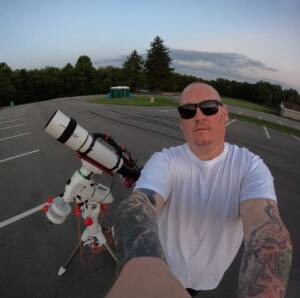
Discovery of the M31 [OIII] emission arc
Recently, a major discovery by an international team of amateur astronomers and scientists has become a huge online hit, and this new discovery is just located in one of the

Hi! I’m Vincent Fournaise, earthling, head in the moon, spirit in the sky! My passion for astronomy remains intact for years and today I recently have the chance to work at Optique Unterlinden, the best astronomy shop in France! 😉

I’ve two setups:
The main is composed by:
The secondary is full ZWO

Not during the best news, it was the first confinement in France, in March 2020. However, it was the greatest weather ever! 7 days all with clear nights! Unbelievable!
I have the chance to have a garden, in Bortle sky 4-5 and envoy every night to image during this period.

When I was a teenager, I wondered a lot about what we saw in the sky on summer nights. One day I came across an astronomy site and fortunately the store was not that far from my home! Since then I have filled the trunk of my car on each visit!
First I was fully a visual observer until I bought a T adapter for my APN, connected to a 350 Newton goto dobson: I see so much more with only 10 secondes than my eyes … The viral astrophotography began here! Then I decided to buy a Sky-watcher AZ-EQ6 GT mount with a Sky-watcher 200/800 carbon tube.
I spent so many nights, learning, facing so multiple problems that I became very technical astrophotographer. My auto guiding must be as perfect as possible, I learn every parameter of PHDguiding, I disassembled my mount, degreased/greased the mechanical parts, finely adjust the mechanic, spend many hours to use Pixinsight, participated to a Pixinsight formation, (the great AIP team), changed some parts of my setup to improve stability, quality, ergonomics, etc.
It’s like work: the more you work, the better you are!

Time! With time, you have time to learn each complex part: installation, stationing, time to shoot, time to sleep, software learning, image processing, etc.
Of course, motivation and perseverance are really important but if you have enough time to watch on the internet how difficult astrophotography is, you’ll know it 😉

There is a lot of existing Youtube channel. You often have very basic tutorials. With my explanations I go in deep and in a very educational way, how each mechanical part works, how to take the best pictures and how to be a great astrophotographer… I try not to miss every single detail of course with my touch of humor!
Link: https://www.youtube.com/channel/UC9zQyNsYr7HpsJT8-tb4p7A

I try to travel twice a year going to very dark places (sky Bortle 1/2)
I call this astro hiking holidays! Every day it’s possible: sleeping, hiking, eating, shooting in a loop 😉
Sometimes my little trick is shooting the color in my garden and the luminance under the best dark sky.
What experiences to tell you?!
Often the simplest experiences are the most memorable. Traveling the sky with a pair of binoculars, 15×70. Watching M31, how big he is!
Almost every outing is memorable: the first time seeing an object, the friends with whom it was, the meeting with an animal, the contact with nature, the cosmic journey I take in my eyes…

I’ve no children yet, that facilitates this hobby. My wife knows this passion is important for me and it’s a beautiful activity, why she will stop me ?! :-p
She likes my work very much, every new picture I edited becomes his wallpaper on his mobile phone lol

ZWO and its great best value quality have quickly been a buzz after the astronomy community. I start with ASI1600MM Pro after using an APN and the performances were up to my expectations, more sensible, better color, more details, etc.

I was waiting for an APS-C mono sensor, then comes the new ASI2600MM Pro that I just bought, what can I ask better?!
For me, this APS-C sensor size will be enough, with the right pixel size, that will be just what I need for my 200/800.
In the future; the real point will be will improve sensitivity again and again!

Timeless.

Like every year, my goal is to perform always more and more, investing in new gears to improve the last percentage that makes the difference between the standard and the high-quality photography. And shooting less-known targets in the sky. And a new chapter begins with the ASI2600MM Pro!


Recently, a major discovery by an international team of amateur astronomers and scientists has become a huge online hit, and this new discovery is just located in one of the

That 11-year-old boy staring at Horsehead Nebula photo would never have imagined… Decades later, he’d be capturing amazing deep-sky images from his Florida backyard! “ It was amazing to see

Hello,Sara Harvey,thanks for accepting our interview invitation. Congratulations on winning the ASIWEEK competition in week! Q1: At first, congratulation that your nice image won #ASIWEEK. Can you introduce yourself to

Astrophotography is more than just capturing images of the night sky—it’s a journey of discovery, patience, and creativity. For this passionate astrophotographer, what started as a chance encounter with a

Taranjot Singh, an Indian origin Australian astrophotographer who is making waves on the international stage. Taranjot has been recognized as one of the Top 5 finalists in the prestigious Siena

The back focal length is advised by telescope manufacturers. Since most telescopes have a 55mm back focal length, we are here to provide detailed instructions for all ASI cooled cameras.Please
1 Comment
NicolasM
Congratulations Vincent ! And thank you for your amazing videos !